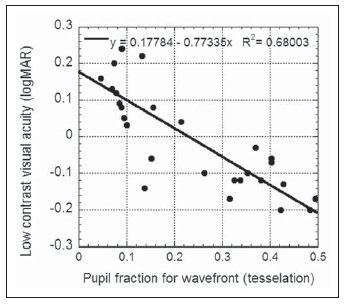Penetrating Keratoplasty for Keratoconus: The Nexus Between Corneal Wavefront Aberrations and Visual Performance
PURPOSE: To compare the visual and optical performance after penetrating keratoplasty (PK) for keratoconus to normal patients and to examine the relationship between corneal wavefront aberrations and visual performance in patients with PK.
METHODS: Visual performance testing, with optimal refractive correction, included low contrast visual acuity (LCVA) and Pelli-Robson contrast sensitivity with and without glare, and high contrast visual acuity. Corneal fi rst surface wavefront aberrations were calculated from EyeSys topography data using VOL-Pro software v7.00 for a 4.0-mm pupil as a 10th order Zernike expansion and converted into single value metrics. Normal patients were compared to patients with PK using analysis of variance, and linear regression was used to compare wavefront aberration metrics to visual performance.
RESULTS: Patients with PK (n=14, age 41.6 ±7.0 years) and normal patients (n=14, age 36.7 ±9.0 years) were of similar age (F1,26=2.54, P=.12). Normal patients saw significantly better on all visual performance measures and had better optical performance for total higher order root-mean-square corneal wavefront aberration (mean±SD): PK, 0.67 ±0.41 µm; normal, 0.09 ±0.02 µm (F1,26=28.41, P<.001) and across all Zernike orders and modes. Wavefront aberrations in PK eyes were dominated by trefoil 0.35 ±0.27 µm, coma 0.47 ±0.37 µm, spherical aberration 0.17±0.10 µm, and tetrafoil 0.12 ±0.07 µm. The relationships between corneal wavefront aberration and visual performance metrics were strongest for LCVA=0.30-0.98Pupil fraction for wavefront (tessellation) 0.04Half width at half height, R2=0.75.

Figure 3. The single-value wavefront aberration metric Pupil fraction for wavefront (tessellation) explains 68% of the variance in low contrast visual acuity. This metric is calculated by tessellating the pupil area into 1% subapertures and determining the fraction of the pupil area for which the optical quality of the eye is good enough to meet a certain criterion (eg, λ /4).
CONCLUSIONS: In this series, patients with PK had poorer visual performance compared to normal patients, which is due to increased corneal wavefront aberrations. Outcomes research in corneal transplantation should include measurement of wavefront aberrations and visual performance in the contrast domain.
J Refract Surg. November 2006;22:926-931.
Konrad Pesudovs PhD
Douglas J. Coster, FRANZCO, AO
NH&MRC Centre for Clinical Eye Research, Department of Ophthalmology, Flinders Medical Centre and Flinders University, Bedford Park, South Australia, Australia

Wavefront aberrations after PK as PDF (180 Kb)
![]()
Index of Papers
[ Welcome ][ Publications ]

